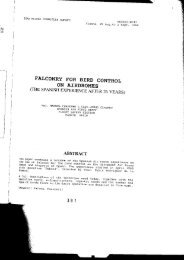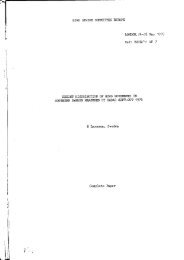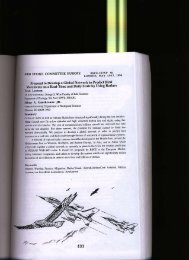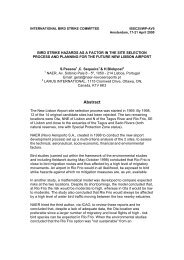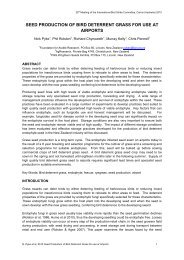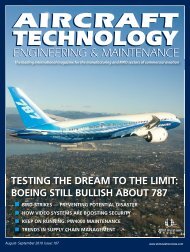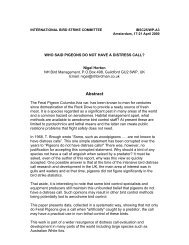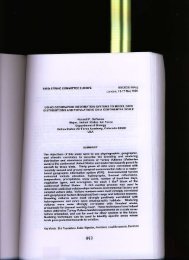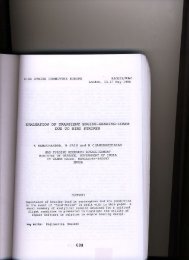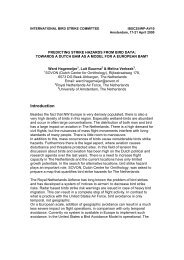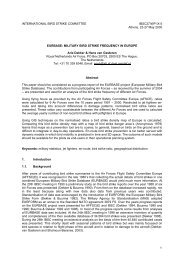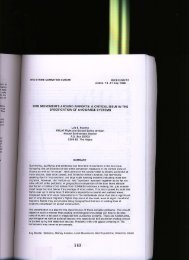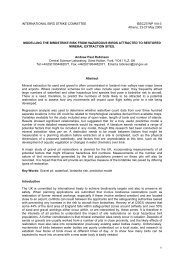Standards for aerodrome bird/wildlife control - International Bird ...
Standards for aerodrome bird/wildlife control - International Bird ...
Standards for aerodrome bird/wildlife control - International Bird ...
You also want an ePaper? Increase the reach of your titles
YUMPU automatically turns print PDFs into web optimized ePapers that Google loves.
9. Data required in a <strong>bird</strong>strike report<br />
The more in<strong>for</strong>mation that is recorded about a <strong>bird</strong>strike incident the better. As a<br />
minimum, the data required on the ICAO <strong>bird</strong>strike reporting <strong>for</strong>m should be collected<br />
as fully as possible. If some data items are not available (e.g. altitude of strike) then<br />
as much in<strong>for</strong>mation as possible should be collected and due account taken of the<br />
missing data during subsequent analyses.<br />
Standard 7<br />
Airports should establish a mechanism to ensure that they are in<strong>for</strong>med of<br />
all <strong>bird</strong>/<strong>wildlife</strong> strikes reported on or near their property.<br />
The total number of <strong>bird</strong>strikes should never be used as a measure of risk<br />
or of the per<strong>for</strong>mance of the <strong>bird</strong> <strong>control</strong> measures at an airport.<br />
Airports should ensure that the identification of the species involved in<br />
<strong>bird</strong>strikes is as complete as possible.<br />
Airports should record all <strong>bird</strong>strikes and include, as far as they are able,<br />
the data required <strong>for</strong> the standard ICAO reporting <strong>for</strong>m<br />
National Regulators should collate <strong>bird</strong>strike data and submit this to ICAO<br />
annually.<br />
10. Submission to ICAO<br />
Although this is not a matter directly <strong>for</strong> individual airports, countries should be<br />
encouraged to collate <strong>bird</strong>strike data at the national level and to submit this to ICAO.<br />
This assists in assessing the true levels of <strong>bird</strong>strike risk and costs to the aviation<br />
industry of <strong>bird</strong>strikes around the world.<br />
11. Risk Assessment<br />
Formal risk assessment is now routinely used in almost all aspects of health and<br />
safety work. <strong>Bird</strong>/<strong>wildlife</strong> strike prevention has tended to lag behind in this field<br />
because the involvement of <strong>bird</strong>s and other <strong>wildlife</strong> (creatures whose behaviour can<br />
vary hourly, daily and seasonally, and whose populations can fluctuate over longer<br />
periods) as a key component of the system being assessed makes it difficult to<br />
accurately predict risk levels. Techniques are now available that make use of the<br />
frequency that each species is struck, combined with probability of aircraft damage<br />
<strong>for</strong> that species, to calculate risk levels <strong>for</strong> a particular airport. These allow risk<br />
assessment matrices to be constructed and updated annually in order to evaluate<br />
how the risk level is changing in response to the <strong>bird</strong> management measures in<br />
place.<br />
16



